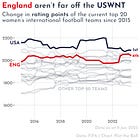⛳ Rory McIlroy, Scottie Scheffler and conventional golfing wisdom
For show
Welcome to the 17th edition of Plot the Ball for 2023.
If you missed the previous edition, you can read it here:
The Open starts tomorrow at Royal Liverpool Golf Club — and Rory McIlroy will be looking to continue his strong recent form as he seeks a fifth major title. I first wrote about McIlroy’s historical record after he won the 2022 FedEx Cup last September; below, I have gone a little bit deeper into his specific strengths on the course, how they align with Scottie Scheffler’s and what that means for how their performances are interpreted.
Rory McIlroy, Scottie Scheffler and conventional golfing wisdom
The assertion that the greatest top-level athletes are in complete control of the effects of their actions — that they have the ability to bring about an outcome purely by willing it to be so — is in fact one of the greatest sporting fallacies.
This — a line from a piece in The Athletic on Rory McIlroy’s recent second-place finish in the US Open — is the sort of thing I’m talking about:
The error in interpreting outcomes in this manner is to mistake a combination of skill, contingency and fortune for pure skill and force of will.
No one — no matter what they may claim1 — stands on a green and ‘knows’ that they’re going to make a putt.
With that said, the experience of watching golfers like McIlroy and Scottie Scheffler near the peak of their powers — currently the two best golfers in the world by some distance, according to gold-standard statistics website Data Golf — is a pretty novel one.
Each player is so stunningly good from tee to green that they’re constantly putting themselves in great positions — but their putting isn’t nearly as elite, and so they don’t take advantage of those positions as often as many others could.
While it’s wrong to state that even the greatest golfers of all time were ever certain that they would drain a given putt, it’s inarguable that both McIlroy and Scheffler don’t hole as many as casual fans might think given their overall skill levels.
It’s important to stress that this isn’t a reflection of their performance in ‘higher-stakes’ competitions2.
It’s simply a reflection of the distribution of their skills relative to the world’s other top golfers.
To briefly summarise: they are the second (Rory) and third (Scottie) best golfers ranked by True Strokes-Gained3 Tee to Green since Shotlink records began in 2004 — but the 199th and 285th respectively by Strokes-Gained Putting over the same period.
The Courchene brothers at Data Golf put a nice, data-driven spin on conventional golfing wisdom when they wrote the following about Collin Morikawa in January:
"Much of professional golf is about plodding along and making the most of good putting weeks.”
Because of the distribution of their skills, Scheffler4 and McIlroy will simply have fewer of those good putting weeks than most — and it can feel to observers like they’re squandering more opportunities than others as a consequence.
Putting is a much smaller part of the game5 than ball-striking off the tee and approach play, though, and getting yourself into advantageous positions repeatedly is by far the most important thing.
That’s why — for all the frustration that they often have to weather from onlookers — Rory and Scottie are still clearly the top two golfers in the world.
Substack has recently launched a subscriber referral scheme, which enables writers to offer additional benefits to readers who spread the word about their favourite publications.
If you enjoy this newsletter, please consider inviting a friend to read it too. By following these instructions, you will start to earn a number of additional rewards whenever they subscribe!
You can find the code for this piece on GitHub here
Or, for that matter, what they tell themselves standing over the ball; no one can ‘will’ away the impact of the external conditions which introduce uncertainty into every sporting action.
Both McIlroy and Scheffer perform better in majors than non-majors, according to Data Golf.
Sujeet Indap interviewed the inventor of Strokes Gained, Mark Broadie, for a potted history of the metric in a recent article in the Financial Times.
If you want to look into more data on Scheffler’s putting, I’d recommend this edition of the Data Golf newsletter from a few weeks ago.
Over this period — since 2004 — the best putters gained around 0.7 shots per round over the average PGA Tour player on the greens; the best tee-to-green players gained around 2 shots per round from tee to green.




